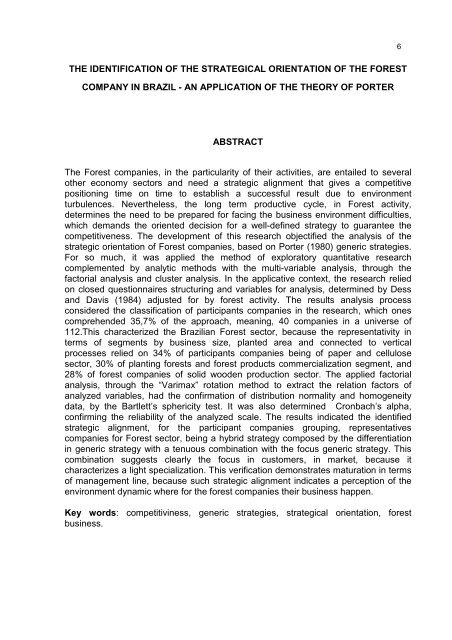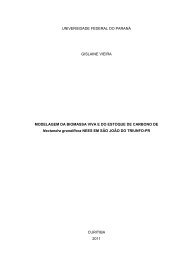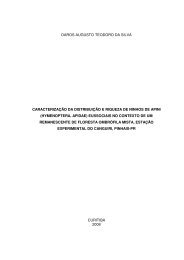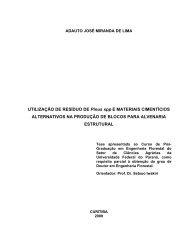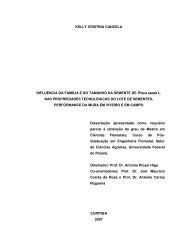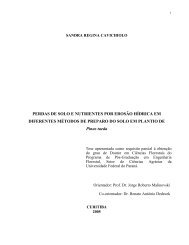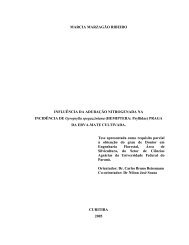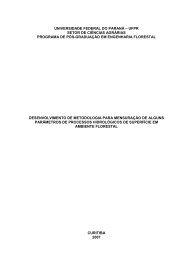andré germano vasques - departamento de engenharia florestal ...
andré germano vasques - departamento de engenharia florestal ...
andré germano vasques - departamento de engenharia florestal ...
Create successful ePaper yourself
Turn your PDF publications into a flip-book with our unique Google optimized e-Paper software.
THE IDENTIFICATION OF THE STRATEGICAL ORIENTATION OF THE FOREST<br />
COMPANY IN BRAZIL - AN APPLICATION OF THE THEORY OF PORTER<br />
ABSTRACT<br />
The Forest companies, in the particularity of their activities, are entailed to several<br />
other economy sectors and need a strategic alignment that gives a competitive<br />
positioning time on time to establish a successful result due to environment<br />
turbulences. Nevertheless, the long term productive cycle, in Forest activity,<br />
<strong>de</strong>termines the need to be prepared for facing the business environment difficulties,<br />
which <strong>de</strong>mands the oriented <strong>de</strong>cision for a well-<strong>de</strong>fined strategy to guarantee the<br />
competitiveness. The <strong>de</strong>velopment of this research objectified the analysis of the<br />
strategic orientation of Forest companies, based on Porter (1980) generic strategies.<br />
For so much, it was applied the method of exploratory quantitative research<br />
complemented by analytic methods with the multi-variable analysis, through the<br />
factorial analysis and cluster analysis. In the applicative context, the research relied<br />
on closed questionnaires structuring and variables for analysis, <strong>de</strong>termined by Dess<br />
and Davis (1984) adjusted for by forest activity. The results analysis process<br />
consi<strong>de</strong>red the classification of participants companies in the research, which ones<br />
comprehen<strong>de</strong>d 35,7% of the approach, meaning, 40 companies in a universe of<br />
112.This characterized the Brazilian Forest sector, because the representativity in<br />
terms of segments by business size, planted area and connected to vertical<br />
processes relied on 34% of participants companies being of paper and cellulose<br />
sector, 30% of planting forests and forest products commercialization segment, and<br />
28% of forest companies of solid woo<strong>de</strong>n production sector. The applied factorial<br />
analysis, through the “Varimax” rotation method to extract the relation factors of<br />
analyzed variables, had the confirmation of distribution normality and homogeneity<br />
data, by the Bartlett’s sphericity test. It was also <strong>de</strong>termined Cronbach’s alpha,<br />
confirming the reliability of the analyzed scale. The results indicated the i<strong>de</strong>ntified<br />
strategic alignment, for the participant companies grouping, representatives<br />
companies for Forest sector, being a hybrid strategy composed by the differentiation<br />
in generic strategy with a tenuous combination with the focus generic strategy. This<br />
combination suggests clearly the focus in customers, in market, because it<br />
characterizes a light specialization. This verification <strong>de</strong>monstrates maturation in terms<br />
of management line, because such strategic alignment indicates a perception of the<br />
environment dynamic where for the forest companies their business happen.<br />
Key words: competitiviness, generic strategies, strategical orientation, forest<br />
business.<br />
6


